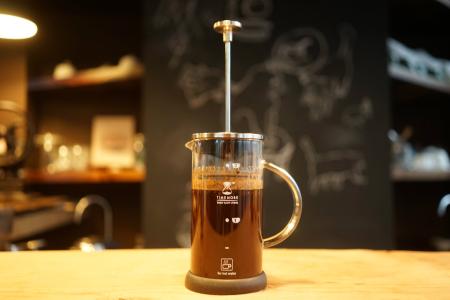The taste of coffee bean honey treatment-three major treatment methods of coffee beans
The taste of coffee bean honey treatment-three major treatment methods of coffee beans
Imported coffee beans treated in this way are often defective and unattractive. Beans dried in the sun are often made of foreign bodies or stones. The flavor of the beans treated by this method is more complex, but it has the taste of the sun, the fruit flavor is very strong, and the consistency is better than the washing method. General Brazilian beans as well as Mantenin and mocha are typical sun-treated coffee beans. Basically all robusta coffee beans are treated with sun-treated honey, just like water washing, which first uses a large sink to pick out ripe coffee fruits, except that honey treatment skips the step of fermenting coffee beans in the pool. Honey treatment first removes the peel of the ripe high-quality coffee fruit, uses a machine to remove the pulp and retains part of the pectin, and then transfers the shell beans with pectin to the outdoor sun field for natural fermentation and drying. Use manpower to turn the coffee beans during the sun to ensure that the coffee beans are evenly exposed to the sun and prevent the return of moisture and odor. In the shell beans reached a certain degree of dehydration, and then with the help of the dryer to further dry, when the water content is about 12%, and finally use the machine to remove the parchment with shell beans, so as to take out the coffee beans. Because the machine can control the percentage of pectin retained, different percentage of pectin will form different colors on the surface of shell beans after exposure to the sun. Therefore, according to the color formed by the sun, Costa Rica further divides the honey treatment into four levels: black, red, yellow and white (the more pectin retained, the darker the color, the higher the cost and the longer the drying time).
Generally speaking, washed coffee beans are bluish green, and due to layers of screening, the beans are very beautiful and have a clear and bright sour taste. Guatemala, Colombia, Blue Mountains, Kenyan, Java and Panama coffee beans are all washed beans. Washing is used in Latin America with the exception of Brazil. Many boutique coffee beans will choose this treatment. However, the water washing method requires more capital and energy investment in the treatment process, and the cost is high. The advantage of this raw coffee bean treatment method is that on the one hand, it saves water. On the other hand, it avoids the problems that are not conducive to the quality of coffee beans, such as mildew in the fermentation process. Mantenin produced in Indonesia is mostly semi-washed. Semi-washing is also used in Brazil in recent years. Brazil is the only country in the world that has both sun, water and semi-washing treatments.
Silver Skin/Chaff: there is a thinner film inside the parchment that wraps the coffee beans. Because the color is glossy and silvery, people used to call it "silver skin". This layer of silver will fall off during baking. Usually when you grind the coffee, you find some silver crumbs in the coffee powder. These crumbs are the silver skins that fail to peel off the coffee beans during baking. Washing method: the peel, pulp and mucous membrane are removed by washing and fermentation. This method is also known as the complete washing method (Fully Washed). Shampoo is the most common way for most coffee-producing countries in the world to handle Arabica coffee beans. Some areas also use advanced high-pressure washing machines to clean the peel, pulp and mucous membrane of coffee beans, so fermentation is no longer needed. This method of using a high-pressure water washer to treat coffee beans is called "Natural Water washing (Pulped Natural). Natural sun drying can retain the fruit aroma of coffee fruit." When you taste this kind of coffee, you will find that the coffee has a fruity aroma and a brighter taste. After drying, people will use special machines to remove the shell of the surface layer. This process is called drying and shelling (Dry Milling).

Important Notice :
前街咖啡 FrontStreet Coffee has moved to new addredd:
FrontStreet Coffee Address: 315,Donghua East Road,GuangZhou
Tel:020 38364473
- Prev

How to mix coffee beans?-how to drink coffee beans when they are ground into powder
How to mix coffee beans? how to drink coffee beans after grinding into powder? another method is to mix different coffee products to change the flavor and increase the sense of flavor distribution. when mixing coffee, we should first emphasize a theme: when mixing different products of coffee, the roasting degree of coffee should be the same, and the particle size of beans should be the same, so as not to destroy the original because some coffee is roasted deeply.
- Next

The brewing water temperature of Japanese coffee beans-brewing coffee with coffee beans
The brewing water temperature of Japanese coffee beans-before using coffee beans to brew coffee ◎, it is necessary to have good water with fresh water after boiling, it will contain the right amount of carbon dioxide to increase the aroma of coffee, but keeping the water boiling will reduce the evaporation of carbon dioxide, so the best water temperature is 92 ℃. If the water temperature is too low, the coffee flavor can not be completely released, and the coffee composition will change if the water temperature is too high.
Related
- Guji coffee producing area of Guji, Ethiopia: Humbela, Shakiso, Wulaga
- What is the most expensive variety of Qiloso in BOP multi-variety group?
- How to store the coffee beans bought home?
- Why are Yemeni coffee beans so rare now?
- Ethiopian Sidamo all Red Fruit Sun Sun Santa Vini Coffee beans
- SOE is mostly sour? What does it mean? Is it a single bean? what's the difference between it and Italian blending?
- Is Italian coffee beans suitable for making hand-brewed coffee?
- How to choose coffee beans when making cold coffee? What kind of coffee beans are suitable for making cold coffee?
- Just entered the pit to make coffee, what kind of coffee beans should be chosen?
- Can only Japan buy real Blue Mountain Coffee? What are authentic Jamaican Blue Mountain coffee beans?

